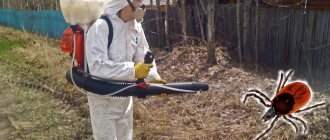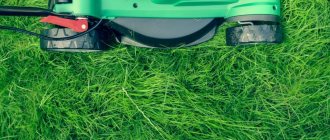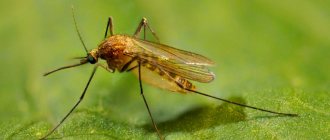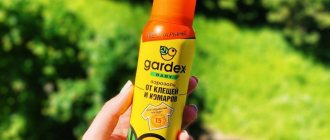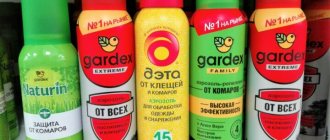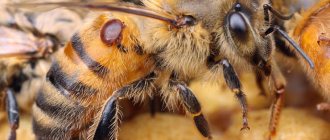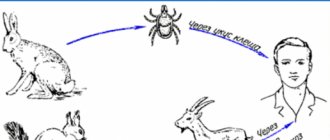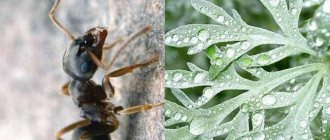Spring is in full swing, which means that blood-sucking arachnids have already woken up and become more active in search of food. How to get rid of ticks in the country?
This arthropod arachnid is dangerous not because it feeds on the blood of people and animals, but because it can be a carrier of serious diseases. Thus, the most common ixodid ticks can infect humans with viral encephalitis, monocytic ehrlichiosis, Q fever, Lyme disease and other dangerous diseases, and dogs with piroplasmosis.
To protect yourself, your loved ones and pets, the territory of the site needs to be treated from ticks, as well as take preventive measures.
How can you tell if there are ticks on your property?
Before starting the treatment process, you must check the area for ticks. This needs to be done twice - before and after processing. The first time to detect ticks, the second, on the contrary, to make sure that they are absent. The simplest and most effective way is to use a white “flag”.
However, before entering the area, it is necessary to protect the body from possible bites. There are a number of measures that can protect you from negative impacts:
- vaccination course against tick-borne encephalitis;
- treating clothing with an aerosol or anti-tick spray (applying it to the body does not make sense, since the substances are interrupted by sweat);
- hermetically seal all exposed parts of the body;
- gather your hair into a bun and tuck your pants into your shoes;
- choose a light color of clothing so as not to miss a tick when inspecting it.
The white “flag” is made from white fleecy fabric using waffle or flannel fabric, which must be treated with human or animal sweat to attract ticks. The design of the “flag” itself is similar and reminiscent of a real flag and is made as follows: fabric is tied to the end and middle of a long stick so that the design looks like a flag.
The verification process involves passing the area several times and applying a “flag” so that it confidently touches the plant surface. You need to walk slowly, avoiding twisting. Every 50 steps it is necessary to check the “flag” for the presence of ticks or plant debris. At the end of the diagnosis, the approximate number of ticks in the entire area of the site will become clear. To avoid getting bitten by a tick, it is important to carefully inspect your clothing before removing it.
Mr. Summer Resident recommends: actions if a tick has grabbed onto the skin
If you find a parasite on your body, you should immediately consult a doctor, who will provide the necessary assistance: he will painlessly remove the entire insect, send it to the laboratory for examination, and give an injection if necessary.
You can get it out yourself, armed with a thread or tweezers. Using a thread, make a knot near the proboscis and progressively pull up, removing the arachnid. Actions should be smooth without harshness.
The ideal is to remove the tick without damaging the body and avoiding suppuration. However, if it is damaged, the area should be wiped with an alcohol solution, and the remaining part (the head) is recommended to be removed using a needle, after which the area is treated again. The extracted arthropod must be placed in a glass container and taken to a specialized place.
When to treat and how often to repeat?
The recommended period for carrying out anti-tick treatment of a summer cottage begins in April and ends in early July. This is the time when ticks are most active, which both poses a danger to humans and makes them easy to kill. Direct processing should be carried out in calm weather and with a favorable forecast that does not imply precipitation for several days in advance.
The procedure must be repeated twice a year: during the recommended period and at the end of summer, because this will help reduce the number of ticks in the area when the next spring arrives. Accordingly, treatment must be carried out annually.
Choosing a means to treat an area against ticks
When choosing a drug, it is based on which mites need to be destroyed and what active substance to use (either based on permethrins or based on organophosphorus compounds). The latter have almost already been abandoned; most often, preparations with the main component in the composition - permethrin - are used against ixodid ticks.
The higher the concentration of the active substance, the more effective the drug. It is advisable to use two-component drugs.
The principle of operation of these agents is based on the fact that when they enter the body of ticks through contact, they cause disruption of the functioning of the nervous system and block the transmission of impulses. This results in muscle paralysis, and subsequently in the death of insects.
What to process?
Regular processing procedures imply the use of a reliable product.
Cifox
The product is used by many disinfection services because it is very toxic and versatile. Thanks to it, your garden plot can be protected not only from ticks, but also from other parasites. The main advantages include:
- fast-acting effect;
- duration of action;
- versatility.
The product is also allowed for use at home, but with extreme caution.
Ram
The peculiarity of the composition of “Taran” does not allow it to immediately begin to act against ticks, however, this is compensated for by its long aftereffect for up to 2 months. The product is not safe to use, which requires additional protection. The main substance is Zeta-cypermethrin.
Acarocide
A universal insect repellent that can eradicate from the garden plot:
- ants;
- bedbugs;
- ticks;
- insect larvae.
The main chemicals in the composition are fenthion and cypermethrin, in 40% and 10% proportions, respectively. Areas of use of the drug for disinfection: closed reservoirs (prohibited in open ones), basements, children's and residential premises, catering facilities.
Medilis Cyper
A highly toxic substance with a specific odor and yellow color. The main active ingredient is cypermethrin in a ratio of 25%. The duration of the drug is about 2 months, and the treatment should be carried out 3 days before moving into the site. The manufacturer recommends, in the absence of knowledge of the type of ticks located in the local area, to treat according to the concentration as against ticks of the genus Dermacentor.
Bytex
It is an insecticidal preparation that is also used in the treatment of medical premises. Suitable for combating ixodid ticks, and the active ingredient is fenthion in a ratio of 40%. The effect lasts for 1 month. In case of unsuccessful treatment or weak effect, re-treatment of the area is permissible.
Dobrokhim FOS
The substance specializes in the destruction of flies, fleas, ants, ticks and other insects in communal premises, catering areas and childcare facilities, excluding exposure to bedrooms, dining rooms and playrooms. The active ingredient is 20% fenthion. Water acts as a solvent, which provides a reduced degree of danger for pets (cats or dogs), livestock and children.
Force site 25%
A remedy for combating various parasites, including ticks of the species Ixodes, Dermacentor, Haemophysalis - those that are the causative agents of tick-borne encephalitis. The main active ingredient is fenthion in a ratio of 25%; auxiliary elements are: antioxidant, stabilizers, fragrance and solvent. Also an emulsion concentrate. Duration of action is from one to two months depending on the level of spraying. The drug can cause an irritating effect on the mucous membranes of the eyes and skin, which classifies it as toxicity group 3 according to GOST.
Sipaz Super
The substance is an emulsion concentrate, which gives it the possibility of a broader effect - on adults and their larvae. The active ingredient is cypermethrin in a ratio of 25%. The manufacturer recommends using it as a medical disinsection at various facilities. After use there are no traces, but a slight odor remains that does not irritate the respiratory tract. Duration of action after use is about 2 months.
Samarovka
An insectoacaricidal agent with a wide spectrum of effects. The active ingredient is cypermethrin (25%), and working emulsions contain up to 0.05% cypermethrin. The effect of the drug begins within 20 minutes after application. The residual effect after use outdoors is up to 4 weeks, and indoors up to 4 months. It is strictly forbidden to apply the product to bodies of water that are used for breeding fish or birds.
Acaritox
The drug goes on sale in powder form, which gives a stable emulsion when dissolved in water. The powder does not clog the nozzles, due to its composition, and also does not produce sediment. The main substance is alphacypermethrin in a ratio of 5%. After use, the residual effect lasts up to 2 months. Without going into the soil with water, thereby remaining on the litter, it provides a negative effect on ticks during their sleep.
Ways to combat ticks
Ixodid ticks pose a huge danger to humans, since as a result of a bite one can become infected with various infectious diseases, especially tick-borne encephalitis. In this regard, a person should avoid meeting ticks. To reduce the risk of tick bites, it is necessary to take appropriate measures, such as timely mowing the grass in the areas, not allowing uncontrolled thickets of vegetation in the area, cutting off the branches of bushes, as well as the crowns of young trees to a height of more than 50 cm from the ground. Such events lead to the creation of unfavorable conditions for the development of these bloodsuckers.
Although such actions reduce the risk of tick bites, they cannot completely insure a person from such an encounter. Ticks can appear in the yard due to the presence of pets who like to visit places with tall grass or thickets of bushes, after which they carry the parasites on their fur to a “sterile” area. In addition, do not forget about stray animals, rodents, etc. The situation is aggravated if there is a forest or park next to the site. The fight against these parasites should be carried out comprehensively, destroying both the pests themselves and taking care of pets, ridding them of ticks.
Need to know! To prevent wild animals, stray dogs and other living objects from appearing on a personal plot or summer cottage, it is better to fence the area, and also to constantly fight rodents, which can also infect the area with ticks.
The use of pesticides to combat ticks is considered the most optimal option. Parasites are destroyed on the site in a couple of days, and after that the site is considered protected for another couple of months. The chemical industry produces toxic substances in the form of concentrated emulsions, solutions, powders, and pellets.
Folk remedies for tick control involve the use of various plants, which, with their strong and persistent aroma, can prevent pests from entering the area. Such activities work well in combination with the use of pesticides.
Are these drugs safe for people, pets and crops?
The safety of the drug depends entirely on its composition. Harm has a different ratio for living organisms. This is clearly seen when using drugs that do not have such a negative effect on the crop as they do on humans. However, most manufacturers recommend waiting at least 3 days after treatment before entering the site.
Do not forget about safety during processing, since failure to comply with safety precautions can lead to adverse health consequences. In rare cases, exposure to chemicals can cause death. That is why it is better to trust the processing to professionals who are not only specially trained, but also have chemical protection.
Sipaz is super
The mosquito and tick repellent treatment is based on cypermethrin. The main task of the drug is to destroy ticks and mosquitoes. Destroys pests at all stages of the life cycle. Sold in liquid form, you will have to pay about 2,000 rubles for 1 liter. Tsifoks, Cypermethrin and Samarovka insecticide have a similar effect. Concentrated emulsion of Tsifoks with a volume of 500 ml costs from 950 rubles. Samarovka insecticide will cost 6,500 rubles for 5 liters of product.
Review
We live next to a pond, so every summer we suffer from mosquito bites, especially children. We decided to try to process the area and bought Tsifoks. The product turned out to be very effective and after the first treatment it gave an excellent result. They were saved from bloodsuckers for the whole year.
Viktor Sergeevich, Krasnodar
Self-processing or calling a specialist?
Self-treatment of an area against ticks requires the owner to be thoroughly aware of all procedures and comprehensive chemical protection. It is necessary to study the literature, find time for a favorable forecast and calm weather, and also purchase all the equipment. As a result, having decided to process the site yourself, you have to spend not only money, but also time. This option is not beneficial for everyone, especially considering that some time must pass after processing.
Oleg Roshchin
I am a professional exterminator, I have been removing insects from apartments and private houses for 7 years.
Calling a specialist is much easier. The company the owner contacts will have everything necessary and will select favorable weather conditions for processing. The owner of the site only needs to pay and agree on the choice of means that will be used to treat the site. The approximate cost of professional processing is determined by the size of the site and its distance from the city. Basically, companies require 600 rubles from 1 hundred square meters and about 400 rubles from 40 hundred square meters, then, as a rule, the price is negotiable. In this case, the owner spends money but saves time.
Considering all the facts, the most favorable solution for people who have not done processing before is to call specialists. Even if you buy equipment and learn the process, it will not pay for itself. This takes a lot of time, and treating the area more than 2-4 times a year is dangerous both for health and for the area.
How does the poison work?
The use of toxic substances is carried out only on the basis of certain rules, otherwise it can harm both the environment and humans. Such chemicals are developed on the basis of broad-spectrum insecticides. The main components are considered to be of low or moderate toxicity, therefore, under certain conditions, they will not cause significant harm.
Treatment with such control agents leads to the death of all insects that are in the area of action of the drug. Spraying can be safe for animals if after treatment there is no contact with the substance for 3 days. If you do not adhere to these standards, then allergic reactions of the body may occur, expressed by increased salivation, lacrimation, loss of appetite, diarrhea, as well as nausea and vomiting.
Chemical anti-mite agents have a contact effect, penetrating into the insect’s body through the chitinous layer. As a result, the function of the nervous system is impaired, leading to paralysis and eventual death. During the first 3 days, the toxic substance acts with maximum effect, and then its toxicity gradually decreases. At the same time, the product is poisonous for ticks for several months.
It is important to know! It is prohibited to carry out anti-tick treatment of a summer cottage or garden plot during periods of harvest ripening. It is allowed to carry out such processing no earlier than 3 weeks before harvest.
You can work with chemical control agents only in personal protective equipment - a respirator, goggles, rubber gloves, shoes, hats, and thick clothing. Toxic components must not be allowed to come into contact with the skin, eyes, and especially the respiratory tract. If these requirements are ignored, poisoning of varying degrees of severity is possible, with headache, dizziness, nausea, vomiting, diarrhea, etc. Toxic components are especially dangerous for children, expectant mothers, allergy sufferers, and people with weak immune systems.
Features of treating the area against ticks and mosquitoes
Types of mites and which trees are affected (in the garden)
Today there are many different types of spider mites known. All of them affect some plants and crops. Here we will note only the most common varieties of these insect pests.
So, among the most famous spider mites, today we can easily distinguish the following types:
- The common spider mite infects grapes, fruit and stone fruit plants, berries, as well as grains, legumes, and decorative indoor and outdoor crops.
- Red spider mite - damages balsam, lemon, nightshade, roses, orchids.
- The hawthorn mite can be found on Rosaceae: cherry plum, hawthorn, plum, apricot, rowan, apple tree.
- The date spider mite loves melons, eggplants, date palms, and a variety of grains.
- Petrobia polyphagous is capable of infecting over two hundred economically important plants, in particular various cereals, onions, asparagus, strawberries, garlic, cucumbers, spices, clover, and various legumes.
- The Turkestan spider mite settles on Theophrastus abutilon, acacia, cotton, mantle, sunflower, burdock, alfalfa, field bindweed, swan, melon, watermelon, nutmeg pumpkin, datura, cucumber, quince, common hop, and ve white, plum, nightshade, clover, eggplant, grapes, elm and corn.
- The Atlantic spider mite loves cotton, apple and pear trees, clover, alfalfa, and strawberries.
- The red fruit mite can be found on deciduous rosacea trees. In addition, it often attacks grapes, alder, elm, oak, linden and mulberry.
- The red citrus mite is very fond of tangerines, oranges, lemons and other citrus crops.

